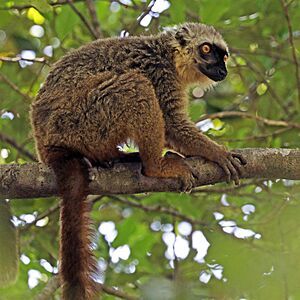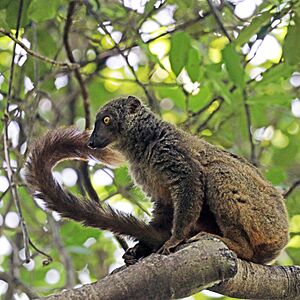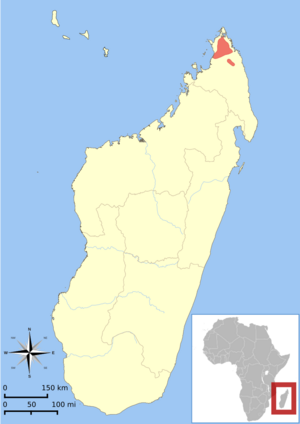Sanford's brown lemur facts for kids
Quick facts for kids Sanford's brown lemur |
|
|---|---|
 |
|
| Male | |
 |
|
| Female both in Ankarana Reserve |
|
| Conservation status | |
| Scientific classification | |
 |
|
| Distribution of E. sanfordi |
The Sanford's brown lemur (which scientists call Eulemur sanfordi) is a type of primate that lives on the island of Madagascar. It's part of the Lemuridae family, which includes all true lemurs.
This lemur was once thought to be a kind of common brown lemur. But in 2001, scientists decided it was its own special species. It got its name from Leonard Cutler Sanford, who was a helper at the American Museum of Natural History.
Contents
Physical Features of Sanford's Lemur
Sanford's brown lemur is a medium-sized animal. Its body is about 38 to 40 centimeters (15 to 16 inches) long. Its tail is even longer, reaching 50 to 55 centimeters (20 to 22 inches). This means a lemur can be almost a meter long from head to tail! They usually weigh around 1.8 to 1.9 kilograms (about 4 pounds).
These lemurs are special because males and females look different. This is called being sexually dichromatic.
How Male Sanford's Lemurs Look
Male lemurs have fur that is gray to brown on their backs. This fur gets darker near their hands, feet, and the base of their tail. Their belly fur is a lighter gray or brownish-gray. Their tail is dark gray.
Their nose, mouth area, and face are black. The fur around their face is white or light gray. What makes them stand out are their ear and cheek tufts. These tufts are longer and look spiky. They can be white, cream, or even reddish. The reddish color might happen if they mix with crowned lemurs. Male Sanford's lemurs also have a light brown "cap" on top of their heads.
How Female Sanford's Lemurs Look
Female lemurs have gray-brown fur on their backs. This fur gets darker gray around their shoulders and the top of their head. Their belly fur is a lighter gray. Their face is also gray, sometimes with light patches above their eyes. Their tail is often darker than their body, from gray-brown to dark gray.
It can be tricky to tell female Sanford's lemurs apart from other lemurs. But if you look closely, female Sanford's lemurs do not have light spots at the corners of their mouths. They also tend to have longer, bushier fur on their cheeks.
How Sanford's Lemurs Live
Where They Live
Sanford's brown lemurs live at the very northern tip of Madagascar. You can find them in places like Antsiranana and Ampanakana. They mostly live in a few forests, such as Ankarana, Analamerana, and Montagne d'Ambre. There's also a small group in the Daraina area.
They live in different kinds of forests, including wet tropical forests and dry lowland forests. They can also be found in mountain forests up to 1,400 meters (about 4,600 feet) high.
In the Ankarana forest, they seem to like forests that are growing back after being cut down. They are active both during the day and at night. They are most active in the afternoon and evening, sometimes even at night.
Sanford's brown lemurs sometimes hang out with crowned lemurs. This often happens during the wet season when there is more food. This friendly behavior might explain why some lemurs are a mix of both species.
Living in Groups
Sanford's brown lemurs live in groups called "troops." These troops can have anywhere from 3 to 15 lemurs. The size of the group can change depending on where they live.
Each troop protects its own area, which can be as big as 14 hectares (about 35 acres). They usually scare away other groups by making loud calls. They don't often fight violently to defend their home.
It's interesting that female lemurs in this species don't seem to be in charge. This is unusual for many lemur species, but it's common for brown lemurs.
Reproduction and Babies
Sanford's lemurs usually mate in late May. Babies are typically born in late September or early October. The mother carries the baby for about 120 days before it's born.
Most of the time, only one baby is born. But sometimes, in zoos, they can have twins. When they are first born, baby Sanford's lemurs cling to their mother's chest. After about two weeks, they move to her back. Young lemurs usually stop drinking milk from their mother when they are three or four months old. They become adults and can have their own babies when they are two years old.
What They Eat
These lemurs mostly eat fruit. But they also eat other parts of plants, like buds, young leaves, and flowers. What they eat can change depending on what's available during different seasons.
Sometimes, they also eat insects like centipedes, millipedes, and spiders. They don't eat insects for food, but rather to get rid of them. These insects can bite and might even be harmful because they have toxic liquids.
One cool thing they do is "millipede washing." If a lemur bites or bothers a millipede, the millipede lets out a defensive liquid. The lemur might then rub this liquid on its body. This helps to keep away biting insects, like mosquitoes that can carry diseases.
Protecting Sanford's Lemurs
Sanford's brown lemur is considered an Endangered species. This means there are not many of them left, and they are among the rarest brown lemurs.
The biggest dangers to their survival are:
- Habitat loss: Their forest homes are being cut down for logging and mining.
- Hunting: People are starting to hunt them more. Locals in the Antsiranana area sometimes hunt them for food or keep them as pets.


